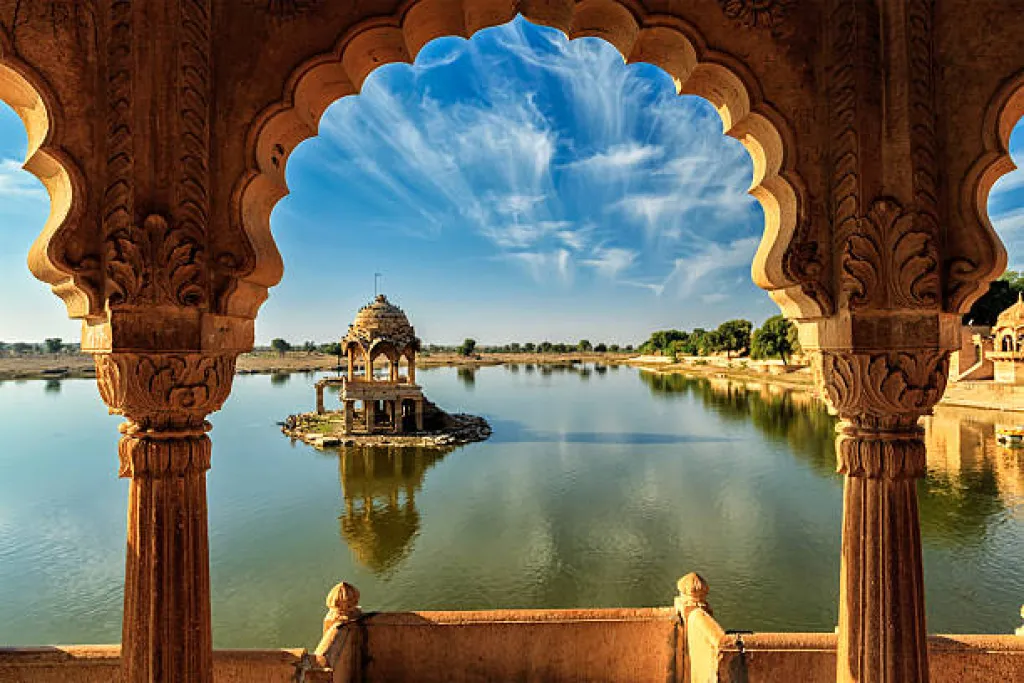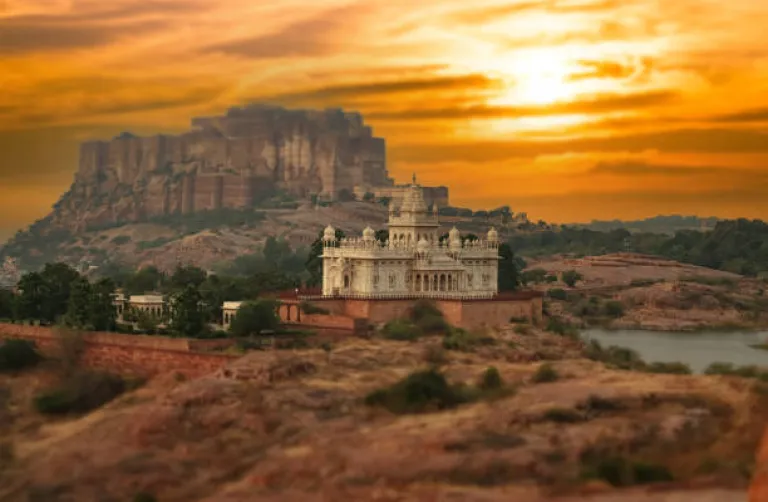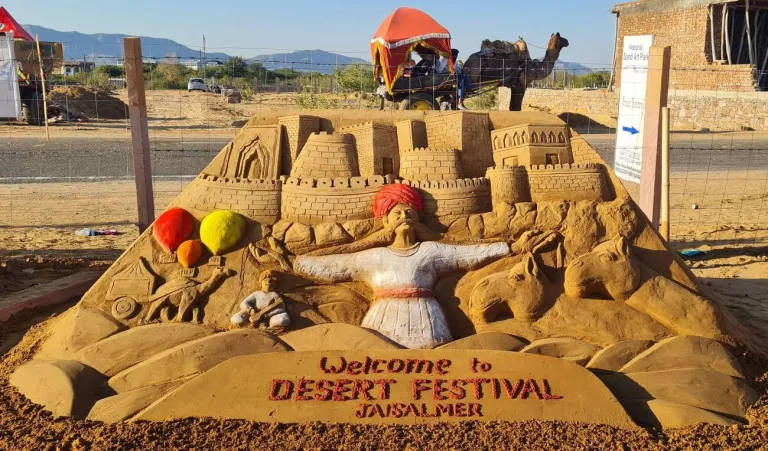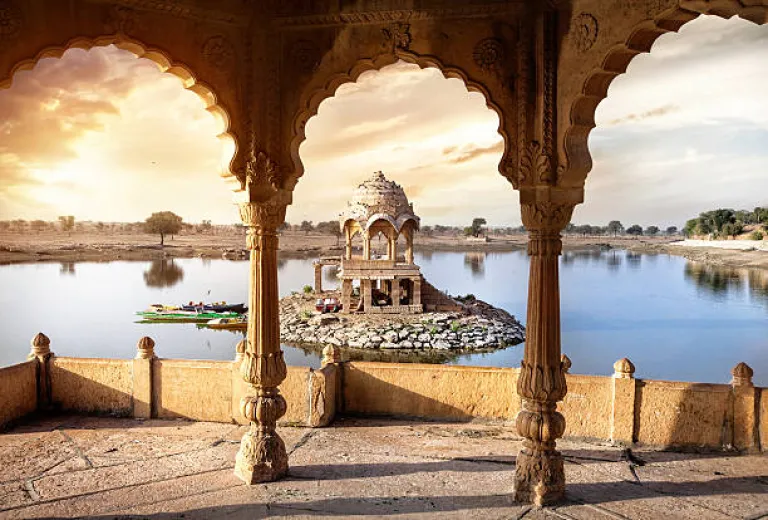Best time to visit Jaisalmer, Rajasthan for Tourists

Jaisalmer, the Golden City, is one of Rajasthan's most romantic desert destinations. With its evocative sand dunes, imposing fort, ancient havelis, folk culture, camel safaris, and magical nights, it draws all kinds of travelers. But depending on when you go, your experience can vary a lot.
Weather, crowds, costs, and events all shift with the months. Here’s everything you need to know to pick the best time for your trip.
What makes Jaisalmer truly special is how it transforms with the seasons, sometimes drenched in festive colors, sometimes cloaked in serene desert silence. A winter evening here can feel like a scene from a fairytale, while a summer day might challenge even the most seasoned traveler.
Add to that the rhythms of local fairs, the sparkle of desert festivals, and the timeless allure of star-filled skies, and timing your visit becomes just as important as choosing what to see.
Planning Jaisalmer? Here’s the perfect season to explore Rajasthan’s desert gem.
Understanding Jaisalmer’s Climate & Seasons

To plan better, it helps to know what you’re up against:
Jaisalmer lies deep in the Thar Desert: summers are extremely hot, winters are dry and cold at night, and monsoon rains are modest but do arrive.
Peak daytime temperatures in summer (May–June) can touch 41-42 °C or more. Nights are somewhat cooler but still very warm.
Monsoon (roughly July-September) brings higher humidity, occasional thunder showers, some rain, and dust or sandstorms. But rainfall is limited compared to many other parts of India.
Winter (mid-November through February) is pleasant during the day, quite cold at night (especially in December & January). Often considered the ideal season weather-wise.
Here’s a quick glance at average monthly high & low temperatures and rainfall:
Month | Avg High Temp (°C) | Avg Low Temp (°C) | Rainfall / Notes |
|---|---|---|---|
January | ~21-23 | ~9-12 | Very little rain; cold nights. |
February | ~25-27 | ~12-15 | Pleasant; days warm, nights cold. |
March | ~31-33 | ~18-20 | Getting hotter by afternoons; early spring. |
April | ~37-39 | ~23-25 | Very hot; days scorch, nights warm. |
May | ~41-42 | ~26-29 | Peak heat; high UV. Not ideal for daytime sightseeing. |
June | ~40-41 | ~27-30 | Extreme heat continues; pre-monsoon activity. |
July-August | ~35-38 | ~25-29 | Monsoon arrives, but rainfall modest; humid, potential for storms/sandstorms. |
September | ~35-37 | ~25-28 | Monsoon wanes; atmosphere cools slightly; humidity drops. |
October | ~30-34 | ~22-25 | Very comfortable; days quite warm, evenings cooler. |
November | ~28-31 | ~15-20 | Ideal weather; many visitors. |
December | ~23-25 | ~10-12 (sometimes lower) | Cold nights; very pleasant days. Great for photography. |
Best Months to Visit: Pros & Cons
Here’s a breakdown by season, what you’ll get, what to watch out for, and what types of travelers each season suits best.
Season | Best Months | Why Go Then (Pros) | What to Keep in Mind (Challenges) |
|---|---|---|---|
Winter | Mid-November to February (especially late Nov, Dec, Jan) | Excellent weather (cool, very livable), festivals, beautiful sunrise/sunset, clear skies, good for desert camps, heritage walks, photography. Desert nights under stars, cozy tents. | Nights can be cold (need warm clothing). Peak tourist season = higher prices on hotels & tents; crowded in popular areas. |
Shoulder Seasons | October; March | Weather transitions: in October, temperatures ease down after summer; in March, things warm up gently after winter. Less crowded, better deals, good weather for daytime exploring. | In March, heat begins to build, mid-day can get uncomfortably hot. In October, event schedules may be less plentiful; some desert camps adjust operations. |
Monsoon / Off-Peak | July-September | Off-peak prices, fewer tourists, dramatic skies, post-monsoon green patches around desert fringe, cooler nights (not always). For adventurous travelers okay with heat/humidity, possible bargain stays. Early September sees arrival of migratory birds. | Heat + humidity; sometimes dusty or windy; some desert camps may not be fully operational; limited services in remote areas. Rain can disrupt travel plans or access to dunes. |
Summer | April-June | Least crowded, you might find cheaper rates; intense desert experience if you don’t mind heat. Sunrise/sunset can be dramatic; strong light for photography. | Very hot during the day (can be intolerable), risk of heat-related issues; many prefer to avoid outdoor strenuous activity. Nights still warm. Many camps reduce services; some travelers avoid altogether. |
Key Events & Festivals to Time Your Visit
To truly experience Jaisalmer beyond its golden fort walls and shifting dunes, it helps to time your trip with the city’s cultural calendar.
Festivals here are not just events, they’re a vibrant fusion of music, dance, traditions, and desert charm that breathe life into the otherwise tranquil sands.
Also read: Bada Bagh, Jaisalmer: Everything you Need to Know Before Visiting!
Jaisalmer Desert Festival (Maru Mahotsav):

Perhaps the most iconic event on the city’s calendar, this three-day extravaganza brings the desert alive with camel races, folk performances, turban-tying contests, and even a “Mr. Desert” competition, offering travelers a spectacular window into Rajasthan’s traditions.
For those planning ahead, the 2026 edition is expected between 30 January and 1 February.
Bird Migration Season:
For nature lovers, Jaisalmer’s charm extends beyond forts and dunes. Every year, the region welcomes the graceful Demoiselle Cranes, which begin arriving around October (sometimes even earlier, depending on rainfall and climate).
These elegant birds can be spotted in flocks near the desert wetlands, creating a serene spectacle for birdwatchers and photographers alike.
Aligning your visit with either of these highlights adds an extra layer of magic, whether it’s cultural vibrancy under the desert sky or the quiet elegance of migrating birds.
Recommendation: Best Time Windows
If you’re wondering when to go, here are the “sweet spots” that balance weather, crowds, and experiences:
Late November to Mid-December:
This period strikes a wonderful balance. The days are pleasantly warm, the nights comfortably cool, and the tourist rush of late December and January hasn’t yet reached its peak.
It’s perfect for travelers who want the best of Jaisalmer’s desert weather without the intensity of holiday crowds or inflated prices.
February (Early to Mid-February):
This is a golden window for travelers. The Desert Festival takes place during this time, so you can enjoy cultural pageantry along with perfect weather, long, sunny days and starlit, crisp nights.
February also coincides with the desert’s subtle seasonal bloom, where hardy shrubs and plants add surprising touches of color to the sands, making safaris even more enchanting.
October:
The early part of the season, October welcomes you with fewer tourists, attractive hotel deals, and mild weather that’s ideal for sightseeing.
It’s before the winter chill sets in, so the desert days are warm but not overwhelming. For those who like exploring in relative quiet, October is an underrated yet highly rewarding choice.
Practical Tips for Visiting During Different Seasons

If traveling in winter: Pack layers, including jackets or sweaters for night. Sun protection for the day. Book tents and desert camps early since they fill fast.
If in summer: Schedule outdoor activities (like desert safari, camel rides) in early morning or late afternoon. Stay hydrated; choose shade; pick stays with good ventilation or air conditioning.
During monsoon / humid season: Check weather forecasts; expect occasional closure or restricted access in some desert areas; pack rain gear; be ready for more of an “experience” rather than easy sightseeing.
In festival time (Desert Festival): Prices go up, lodgings book early; prepare for crowds. But cultural richness, photo ops, entertainment, and local flavor are unmatched.
Why Timing Matters (Beyond Just Weather)
Photography: Winter and early spring give the best skies, crisp air, soft light at sunrise/sunset, clearer visibility.
Desert camps: Many camps offer full amenities in cooler months; some scale back in extreme heat or early monsoon.
Local culture & markets: In peak festival periods, there are more performances, processions, handicraft fairs, local life is more vibrant. In off-peak, some shops may have shorter hours.
Stargazing & night experiences: Winter nights are longer and clearer; fewer clouds; less haze.
Also read: How to Plan Your Rajasthan Itinerary to Enjoy the Best of Everything
Final Thoughts
If you want to enjoy Jaisalmer at its best, aim for late November to February, especially early February if you like festivals.
That gives you the mildest weather, maximum cultural richness, and best blend of comfort + desert magic. If you can tolerate some heat, October or early March are pretty good. Steer clear of mid-summer unless you’re up for a very intense desert experience.
Published at
About Author
Prerna Dixit
Subscribe our Newsletter
Get our weekly tips and travel news!
Related Posts
10 Amazing Things to Do in Azerbaijan That Indians Often Miss
Azerbaijan offers a blend of ancient history, modern architecture, and breathtaking landscapes that Indian tourists often miss. From the mesmerizing Caspian sea to the serene village of Lahij, here are 10 must-do experiences tailored for Indian tourists.
10 Best Places to Visit in Gulmarg, Jammu and Kashmir
Explore the best of Gulmarg, Jammu and Kashmir
10 Most Famous Monuments to Visit in India
Experience the rich heritage and architectural marvels of this diverse land...
10 Must-See Sights in Jaipur, India’s Pink City (2023)
India, with its mysterious and exotic charms, is just the sort of country that even a whole lifetime spent exploring wouldn’t be able to suffice. From the majestic Himalayan mountain peaks to charm...
10 Must-Try Foods for Indian Tourists in Dubai
Dubai is a paradise for Indian tourists, offering a wide array of delicious dishes that blend traditional Middle Eastern flavors with familiar tastes from India. From shawarma to luqaimat, all Indian tourists must try these 10 foods
Latest Posts
5 Bamboo Cottages in Assam with Tea Estate Views Under ₹3500
Discover five charming bamboo cottages in Assam under ₹3500, offering tea estate views, rustic comfort, and immersive stays surrounded by serene green landscapes.
7 Spice Plantation Tours in Kerala You Can Visit and Shop At
Explore seven immersive spice plantation tours in Kerala, offering guided walks, rich farm experiences, and shops selling fresh spices!
Top 7 Craft Beer Breweries in Bangalore with Tasting Tours
Explore Bangalore's 7 best craft breweries! Find must-try beers, prices (₹1500–₹4000 for two), and how to reach each spot.
5 Cliffside Hotels in Varkala with Ocean Views Under ₹6000
5 beautiful Varkala cliff hotels with stunning ocean views under ₹6000. Affordable Kerala sunset views await!
5 Awesome Monsoon Waterfalls in Meghalaya for a Fun Trip in July 2026!
Chase Meghalaya's 5 best monsoon waterfalls in July 2026! See Nohkalikai, Krang Suri, and the roaring Seven Sisters.

